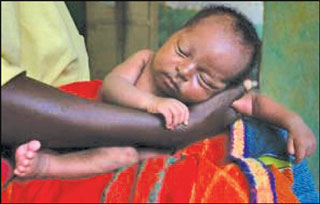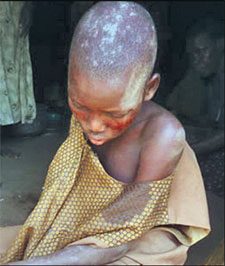|
-new-n.jpg)
Schools in Jaffna Peninsula to be uplifted
by Ananda KANNANGARA
The education of over 10,000 school children in the island schools in
the Jaffna Peninsula will be uplifted by the Northern Provincial
Education Division (NPED).
According to NPED statistics, out of 76 schools which are located in
Delft, Nainathivu (Nagadeepa),Analaitivu, Eluvaithivu, Karainagar,
Punguduthivu and Mandaithivu islands, 18 schools in the islets (small
islands) have temporarily been closed.
Provincial Director of Education, Northern Province, P. Vigneswaran
told the Junior Observer that the objective of the NPED is to discuss
with educational authorities about the reopening of the 18 schools and
providing all 76 schools with required educational equipment, science
laboratories, computer units and library facilities.
“We have also planned to increase the present cadre of 700 teachers
and solve the current teacher shortage in order to recruit teachers for
most important subjects such as English, Mathematics and Science”.
The Provincial Director further said that out of 58 schools in
islands and islets which are presently functioning, a majority conducted
classes from Grades one to 13, while some conducted classes only from
Grades one to six and Grades one to 11.
He said the number of students too ranged from 60 students in a few
schools to between 300 to 600 in others.
Provincial Director Vigneswaran said the Mobile Science Units already
in operation are very popular among students in the schools in the
islands as many children in O/L and A/L classes are benefiting from the
science laboratories for their higher studies.He also said he hoped to
provide mobile computer facilities to needy children in the island
schools and requests educational authorities to visit the schools to
ascertain the education requirements of the schools.
International Women's Day is March 8:
Your role as a woman
Each year around the world, International Women's Day (IWD) is
celebrated on March 8. Thousands of events are held not just on this day
but throughout March to mark the economic, political and social
achievements of women.
The very fact that there is a special day to focus attention on the
female population of the world is an eye opener that there are many
challenges faced by women, especially when it comes to gender equality.
Women have come a long way no doubt in overcoming many of the
obstacles in their way to win equal rights, but there is so much more to
achieve .It is therefore important that all women contribute their mite
to win this goal. Even though you are still a little girl it does not
mean you should not concern yourself about the issues faced by women in
society.
You are very much a part of it too.It has been stated by experts that
“If every International Women's Day event held in 2012 includes girls in
some way, then thousands of minds will be inspired globally.
Perhaps that is why this year’s theme is 'Connecting Girls, Inspiring
Futures'. However, this may not necessarily become the global theme
because individual countries go by their own themes
sometime.Organisations, governments, charities and women's groups around
the world choose different themes each year that reflect global and
local gender issues relavent to them.
The 'Nodding disease' that kills children
 More than 3,000 children in northern Uganda are suffering from a
debilitating mystery ailment known as nodding disease, which has touched
almost every family in the village of Tumangu. More than 3,000 children in northern Uganda are suffering from a
debilitating mystery ailment known as nodding disease, which has touched
almost every family in the village of Tumangu.
For several years, scientists have tried and failed to determine the
cause of the illness, which locals say has killed hundreds of
youngsters.
What they do know is that the disease affects only children and
gradually devastates its victims through debilitating seizures, stunted
growth, wasted limbs, mental disabilities and sometimes starvation.
Joe Otto, a volunteer health worker, explains how nodding disease has
ravaged Tumangu, about 450 kilometres (280 miles) north of the capital
Kampala.
"There are 780 people living in this village and we have 97 cases of
the disease. It has affected almost every family," Otto, 54, told AFP
recently.

Scientists are trying to find a cure: since 2010, researchers ranging
from epidemiologists to environmental experts, neurologists,
toxicologists and psychiatrists have carried out a range of
tests.Investigations have looked at possible links between the disease
and everything from a parasite that causes river blindness, to
malnutrition and the after-effects of a civil war that ravaged northern
Uganda for decades.
"We looked at all this, but unfortunately we were not able to
pinpoint any significant contributing or risk factors," said Miriam
Nanyunja, disease control and prevention officer at the World Health
Organisation in Kampala."The search for the causative agent is still
ongoing," she added.
Last month, after pressure from lawmakers from affected areas,
Uganda's health ministry produced an emergency response plan to try to
identify and control the disease. Patrick Anywar is one of the affected
children.
He 14, lies curled up naked in the dust and midday heat of a Ugandan
village, struggling to look up at his younger brother and sister playing
in front of the family home.
After a minute's effort to face his siblings, Anywar's head slumps
onto his chest and his emaciated body is gripped by convulsions.
Anywar's mother, Rugina Abwoyo, has already lost one son, named Watmon,
to the disease in 2010. Now she says she can do little but watch on
helplessly as another child slips away.
"The disease is terrible -- it does not let him drink or eat by
himself.
"Before he was walking and running like other children, but now
someone always has to stay home to look after him," Abwoyo told AFP.
Courtesy: AFP
Winners of ‘A New Day’ Photography Competition -
November/December 2011 :
[12-14 years ]
1st Place - Reshma Ubeyratna St. Lawrence’s Convent, Colombo
2nd Place - Kavishka Dias Ladies’ College, Colombo
3rd Place - Imashi Perera Holy Family Convent, Colombo
[15-16 years]
1st Place - Pavani Rannulu Museaus College, Colombo
2nd Place - H. A. Rachini Gayanthi Ranaweera Mawathagama Central College
3rd Place - Chamith Rangana Dissanayake D. S. Senanayake College,
Colombo
[17-18 years]
1st Place - Methsarani Lokuge Devi Balika Vidyalaya, Colombo
2nd Place - Sichni Dinsha Ranasinghe Sirimavo Bandaranaike ,Vidyalaya,
Colombo
3rd Place Shakya Gurudasa Ananda College, Colombo |

